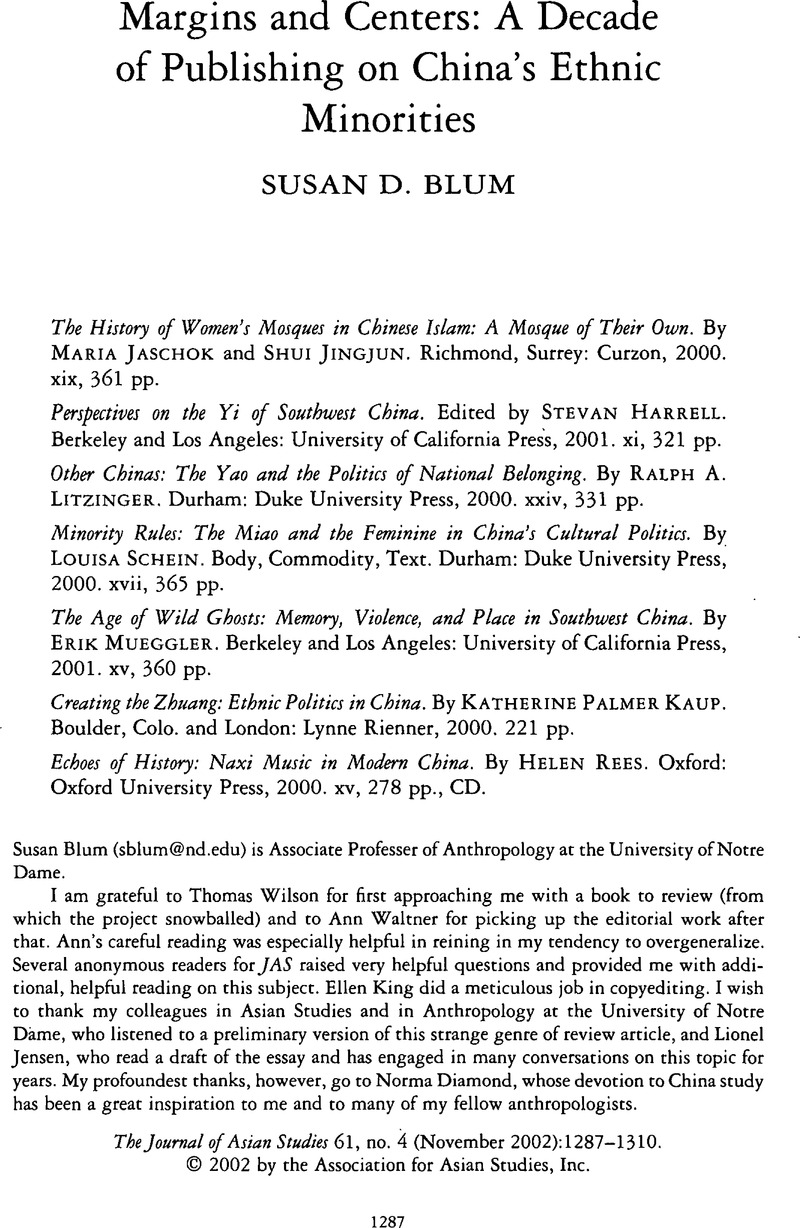Crossref Citations
This article has been cited by the following publications. This list is generated based on data provided by Crossref.
Caffrey, Kevin
2004.
Who “Who” is, and Other Local Poetics of National Policy.
China Information,
Vol. 18,
Issue. 2,
p.
243.
Zhu, Yuchao
and
Blachford, Dongyan
2005.
Ethnic minority issues in China's foreign policy: perspectives and implications.
The Pacific Review,
Vol. 18,
Issue. 2,
p.
243.
Chen, Su
and
Wang, Chengzhi
2008.
Who Has Published What in East Asian Studies?.
Library Resources & Technical Services,
Vol. 52,
Issue. 1,
p.
33.
Borchert, Thomas
2008.
Worry for the Dai Nation: Sipsongpannā, Chinese Modernity, and the Problems of Buddhist Modernism.
The Journal of Asian Studies,
Vol. 67,
Issue. 1,
p.
107.
Komlosy, Anouska
2009.
Marginalization in China.
p.
123.
Anand, Dibyesh
2009.
Strategic Hypocrisy: The British Imperial Scripting of Tibet's Geopolitical Identity.
The Journal of Asian Studies,
Vol. 68,
Issue. 1,
p.
227.
Michaud, Jean
2009.
Handling mountain minorities in China, Vietnam and Laos: from history to current concerns.
Asian Ethnicity,
Vol. 10,
Issue. 1,
p.
25.
Gros, Stéphane
2010.
A heuristic blunder: Notes on an ethnographic situation in southwest China.
Asia Pacific Viewpoint,
Vol. 51,
Issue. 2,
p.
148.
White, Sydney D.
2010.
The Political Economy of Ethnicity in Yunnan's Lijiang Basin.
The Asia Pacific Journal of Anthropology,
Vol. 11,
Issue. 2,
p.
142.
Tapp, Nicholas
2010.
Yunnan: Ethnicity and Economies–Markets and Mobility.
The Asia Pacific Journal of Anthropology,
Vol. 11,
Issue. 2,
p.
97.
Barabantseva, Elena
2011.
The politics of everyday ethnicity in China.
Asian Ethnicity,
Vol. 12,
Issue. 3,
p.
355.
Anand, Dibyesh
2012.
China and India: Postcolonial Informal Empires in the Emerging Global Order.
Rethinking Marxism,
Vol. 24,
Issue. 1,
p.
68.
Jinba, Tenzin
2013.
The Eastern Queendom Dispute and Grassroots Politics on the Sino-Tibetan Border.
Modern China,
Vol. 39,
Issue. 5,
p.
511.
Ho, Wai-Yip
2013.
Mobilizing the Muslim Minority for China's Development: Hui Muslims, Ethnic Relations and Sino-Arab Connections.
The Journal of Comparative Asian Development,
Vol. 12,
Issue. 1,
p.
84.
Kutanan, Wibhu
Srikummool, Metawee
Pittayaporn, Pittayawat
Seielstad, Mark
Kangwanpong, Daoroong
Kumar, Vikrant
Prombanchachai, Thanawut
and
Chantawannakul, Panuwan
2015.
Admixed Origin of the Kayah (Red Karen) in Northern Thailand Revealed by Biparental and Paternal Markers.
Annals of Human Genetics,
Vol. 79,
Issue. 2,
p.
108.
Brunelli, Andrea
Kampuansai, Jatupol
Seielstad, Mark
Lomthaisong, Khemika
Kangwanpong, Daoroong
Ghirotto, Silvia
Kutanan, Wibhu
and
Caramelli, David
2017.
Y chromosomal evidence on the origin of northern Thai people.
PLOS ONE,
Vol. 12,
Issue. 7,
p.
e0181935.
Jiang, Yonglin
2018.
THINKING ABOUT “MINGCHINA” ANEW: THE ETHNOCULTURAL SPACE IN A DIVERSE EMPIRE —WITH SPECIAL REFERENCE TO THE “MIAO TERRITORY”.
Journal of Chinese History,
Vol. 2,
Issue. 1,
p.
27.
Isbister, Dong
Pu, Xiumei
and
Rachman, Stephen
2019.
Chinese Environmental Humanities.
p.
81.
Anand, Dibyesh
2019.
Colonization with Chinese characteristics: politics of (in)security in Xinjiang and Tibet.
Central Asian Survey,
Vol. 38,
Issue. 1,
p.
129.
Fraser, Richard
2020.
Cultural heritage, ethnic tourism, and minority-state relations amongst the Orochen in north-east China.
International Journal of Heritage Studies,
Vol. 26,
Issue. 2,
p.
178.



